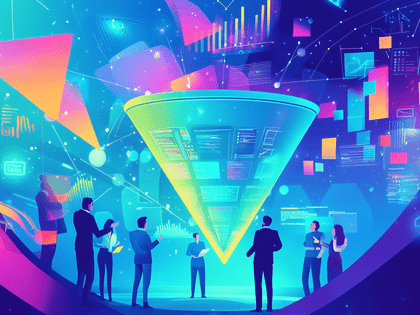Why Your B2B Marketing Funnel Is Too Complex & How to Fix It Fast

- Most B2B marketing funnels fail because they reflect internal structure, not how buyers actually decide.
- Buyers don’t move linearly, they research, loop back, and consult peers before engaging.
- B2B marketing funnels should clarify how to move forward, not just collect leads or clicks.
- Marketing and sales teams must align around clear goals: educate, qualify, and guide, not over-nurture or overproduce.
- Simplifying your marketing funnel means cutting unnecessary steps, clarifying messaging, and using intent-driven content.
- The best funnels reduce friction by centering buyer behavior, not marketing complexity.
Creating overly complex marketing funnels might seem like the best way to catch every opportunity, but it quickly escalates into wasted time, money, and effort. A cluttered funnel makes it difficult to pinpoint what’s actually driving conversions, causing leads to slip through the cracks before turning into a sale. Often, the answer lies in eliminating unnecessary tactics, campaigns, and channels.
At O8, we’ve learned that the more complex the funnel, the more steps there are to manage, test, and optimize. When B2B businesses face slow growth, it’s typically a result of these inefficiencies. That’s why we discussed it in a recent Growth Gears podcast episode.
We’ve summarized the key takeaways in this article, with a few added insights. Whether you're a CEO, CMO, or any executive looking to streamline your B2B marketing, this episode and article offer clear, actionable solutions to help you grow.
The Dangers of Overcomplicating Your Marketing Funnel
Many B2B companies fall into the trap of launching multiple funnels at once, hoping one will eventually succeed. Instead of creating impact, this scattershot approach often leads to confusion, wasted resources, and stalled growth. Teams often become bogged down in ongoing tweaks instead of seeing significant progress.
Overcomplication weakens your B2B marketing funnel and makes it harder to diagnose what’s working and what isn’t.
Common Pitfalls in Complex Marketing Funnels

Excessive Funnel Creation
Organizations frequently launch multiple funnels, such as webinars, eBooks, and quizzes, hoping to cover all bases. This could mean spending on multiple channels or creating unnecessary content across them while still targeting very similar B2B buyer personas.
Add that siloed departments that do not communicate tasks, outcomes, goals, and needs, and you’ve got fragmented marketing 101. This scattershot strategy can dilute focus and effectiveness. Instead, focus on one funnel that aligns well with your goals and perfect it before expanding.
Channel Overextension:
Businesses often spread themselves too thin by trying to maintain a presence on every marketing channel.
Platforms like Facebook, Instagram, X, and TikTok may all seem appealing, but for B2B companies, focusing on LinkedIn can be far more beneficial. Mastering one channel allows for deeper engagement and better results.
Why a Single Funnel for B2B Marketing Outperforms Many
When it comes to B2B marketing, the mantra should be "less is more." Let’s get into the power of one streamlined funnel and how to actually get that done without panicking about lost opportunities.

Focusing on a Single, High-Performing Funnel
- Laser-Focused Efforts: If you pay your entire attention and resources to a single funnel, you can fine-tune your marketing strategy to align perfectly with your ideal customer profile. This focus enables you to effectively guide any potential customer through the B2B sales funnel, increasing conversion rates.
- Optimized Resource Use: Concentrating on a single funnel means you can allocate your budget and time more efficiently. Rather than trying to manage multiple marketing channels and tactics, you can zero in on what works best, such as refining your messaging at each funnel stage.
- Simplified Optimization: Managing and improving one funnel is far simpler. You can conduct targeted A/B tests and adjust based on straightforward data feedback, which is more challenging with multiple funnels.
- Scalability Potential: Once you master one funnel, its success can be replicated. You can expand by creating additional funnels tailored to different segments or products, leveraging the insights gained from the initial funnel.
“The most common issue I've seen is having too many marketing funnels and none of them work particularly well. If one doesn't work, they move to another. Then switch to another one. So don't build too many funnels. Develop one good funnel that generates business for you and then add more.”
Thomas Zandstra, Fractional CMO
Practical Steps to Focus Your Funnel
- Pick the Right Platform: For any B2B marketer, LinkedIn is often the gold standard. It’s where decision-makers spend their time, making it the ideal place to concentrate your marketing efforts.
- Limit Offers: Start with a single, clear product or service; don’t dilute focus with a menu of options.
- Test Ruthlessly: Run small experiments (e.g., two ad versions) and double down on what works, ditching the rest fast. Use the data to refine your strategy, focusing on what performs best.
- Gather Customer Insights: Directly engage with your B2B customers to learn what drew them to your business and what keeps them engaged. This feedback can provide crucial insights to further optimize your funnel.
Fragmented Marketing: How to Cut Through the Noise to Prioritize Correctly
During the podcast conversation, based on our experience with the B2B marketing funnel, we identified some common insights. One key takeaway is that the number one reason B2B companies tend to overcomplicate their funnels is their tendency to chase the next shiny new thing, only to abandon it when another "new" opportunity arises.
This, on the other hand, doesn’t allow much for focused testing and learning. Staying focused on one B2B funnel and reducing complexity, on the other hand, allows you to test and optimize for higher conversion rates and learn how to optimize resource allocation.
Understanding the Chaos
- Chasing the Next Big Thing: It's tempting to jump onto the latest digital marketing trends or tools. However, without clear prioritization, these efforts can become distractions rather than solutions, pulling focus away from effective B2B marketing strategies.
- Lack of Focus: Teams often have an abundance of ideas but lack the execution to bring them to fruition effectively. This can lead to scattered efforts and the dilution of impactful B2B content marketing funnel initiatives.
- Team Structure Issues: Sometimes, the chaos stems from an unclear team structure. Without a solid project manager or a prioritization framework, it's challenging to manage and execute a cohesive marketing strategy.
3 Best Strategies for Prioritization
- Implement a Filtering System: Develop a process to evaluate new ideas, ensuring that only the most promising and relevant initiatives that align with your B2B business goals are pursued.
- Effective Project Management: A dedicated project manager or a robust prioritization tool can help prevent teams from being overwhelmed with initiatives, allowing for better organization and resource allocation.
- Focus on KPIs: Continuously review key performance indicators to identify what’s working. This data-driven approach helps teams make informed decisions, ensuring marketing strategies remain effective and aligned with business objectives.
- Consider Fractional Marketing Services: If your team is struggling to manage it all, fractional marketing services can provide the support you need. You get to build a healthy B2B marketing funnel with C-level marketing experts, and choose to have the execution team too.
Fractional Marketing Is the Future of B2B Growth. And O8 Is There Early.
Stop wasting resources on outdated strategies. Get the strategic leadership and support you need without the overhead of a full-time hire.
4 Warning Signs That Scream Your B2B Marketing Funnel Is Too Complex
If your B2B marketing and sales teams stopped jumping from one tactic to another, or chasing the next shiny new strategy or tool promised to revolutionize your industry, that would be a good start. It would allow more resources to be focused on what’s already working and how to elevate it to the next level.
A marketing funnel that's too tangled can trip up your operations and lead to inefficiencies. In this section, we’ll show you four signs to watch out for:
1. Low Conversion Rates
If your marketing funnel requires potential customers to jump through too many hoops, conversion rates will likely suffer. A clear, direct path is crucial to guiding prospective customers through the B2B sales funnel stages effectively.
In fact, the average sales funnel conversion rate ranges from just 3% to 7%, and complexity only drags that number lower
2. Time Sink
Are you spending too much time tweaking small elements that don't move the needle? If your marketing and sales team is caught up in endless A/B tests on things like button colors, it could be a sign your funnel is bogging them down without delivering real value.
3. Stagnant Growth
When revenue isn't climbing despite a rise in traffic, your funnel's complexity could be stifling your scalability.
A tangled funnel might choke your ability to convert new leads into sales efficiently.
4. Frequent Unproductive Meetings
If you're constantly meeting without making progress on funnel optimization, it might be time to rethink your approach. Effective B2B marketing funnels should encourage action and clarity, not endless debates.
Streamlining your funnel is key to improving its performance. Focus on reducing complexity and ensuring clarity at each stage to help potential customers move smoothly towards conversion. This not only boosts conversion rates but also ensures your resources are well-utilized, driving better business outcomes.
Using KPIs and Meeting Cadence as Indicators of Funnel Health
Tracking Key Performance Indicators (KPIs) and maintaining a consistent meeting cadence can be vital for assessing the effectiveness of your B2B marketing funnel. These elements are crucial for diagnosing issues and ensuring your funnel remains streamlined and effective.

Using KPIs to Monitor Funnel Health
- Spotting the Bottlenecks: KPIs can help you identify where potential customers are getting stuck. For example, if your marketing funnel shows B2B leads dropping off during the interest stage, it might indicate a need for more engaging or relevant content marketing.
- Conversion Rate Benchmarks: Keep an eye on conversion rates at each funnel stage. For instance, Lead to MQL conversion rates typically range from 25% to 35%, while SQL to Opportunity is around 50% to 62%. These metrics provide a benchmark for evaluating the effectiveness of your sales funnel.
Meeting Cadence as a Diagnostic Tool
- Regular Checkpoints: Hold consistent meetings to review funnel performance. If your meetings aren't leading to actionable insights or decisions, it might suggest your funnel needs simplification or refocusing.
- Accountability and Progress: Meetings should end with clear next steps and responsibilities to ensure accountability. This structure can help maintain momentum and drive improvements in the funnel.
By using KPIs and a structured meeting cadence, you can maintain a clear view of your marketing funnel’s health, making it easier to identify and address areas for improvement.
“If your meetings to optimize your marketing funnels aren’t progressing, then you should definitely look at that… it’s not just going to be data at that point, it’s personnel as well.”
- Seth Viebrock, CEO, O8
Data-Driven Funnel Optimization: Aligning Strategy with Business Goals in 3 Steps
There’s only one best way to make sure you have a recession-proof B2B marketing funnel. First, you need to identify bottlenecks with data, align your actions with your goals, and lastly, ask your customers what works. Here’s the breakdown:
1. Pinpoint Bottlenecks with Data-Driven Strategies
Analytics Tools
Leverage platforms like Google Analytics to uncover where your funnel might be losing traction. For example, if you notice low traffic at the awareness stage, it could signal a need to enhance brand awareness through engaging content marketing or targeted advertisements.
If this is too complicated for your non-technical marketing team members, you can now add data visualization tools like Looker Studio or similar platforms to make data insights more accessible and actionable for everyone.
CRM Insights
Examine your CRM data to track email open and click-through rates. If emails are being opened but not clicked, revisiting your email content to better engage potential customers might be necessary.
With HubSpot CRM, for example, you can create customizable dashboards, track key metrics like B2B lead generation, lead scoring, and email performance. These visual reporting dashboards provide your team with clear insights, helping everyone stay aligned and make data-driven decisions, no advanced technical skills required.
2. Decide Which Funnel Stage Needs To Scale
When trying to align strategy with business goals, you need to know what happens in each of your funnel stages and what you need more of.
If your goal is to generate more B2B leads, focus on strengthening the top of the funnel with ads and thought leadership content. It’s no surprise then that 67% of B2B content teams focus their efforts on top-of-funnel content, recognizing its critical role in driving awareness and lead generation.
Conversely, if you aim to boost sales, speed up the decision-making process by offering compelling case studies and clear value propositions. All these decisions should be informed by data and insights from both your sales and marketing teams.
3. Talk to Your Customers
Gathering direct feedback from your B2B customers offers invaluable insights into refining your marketing funnel. By engaging with customers, you can understand why they chose your business and identify the most effective elements of your funnel.
This feedback also reveals which marketing channels and touchpoints are driving decision-making, helping you focus your efforts more strategically. Whether it's targeted email marketing or engaging content marketing, knowing which channels drive the most engagement allows you to focus your efforts more strategically.
Nearly three-quarters of sellers report that 21% or more of their sales pipeline comes from inbound leads, highlighting the importance of investing in the right channels and content to attract qualified prospects.
“Ask your customers—where did they find you? What was interesting to them? Why did they choose you over somebody else?”
- Thomas Zandstra, Fractional CMO, O8
B2B vs. B2C Sales Funnel: Understanding the Key Differences
The B2B sales funnel differs significantly from the B2C customer journey, primarily in terms of decision-making and sales processes.
In B2B SaaS companies, the buyer journey typically involves multiple decision-makers, longer sales cycles, and more complex considerations like ROI and integrations. An effective B2B marketing funnel focuses on educating potential buyers, building relationships, and nurturing leads through longer sales processes.
In contrast, the B2C sales process is often more straightforward, with a quicker path from awareness to purchase. B2C funnels are more centered around emotional triggers, impulse buys, and personalized experiences.
Understanding these distinctions is crucial for any B2B company to design marketing strategies that address the unique needs and decision-making habits of their different B2B buyer personas or Ideal Client Profiles (ICPs).
Conclusions
A high-performing B2B marketing funnel isn’t built by chasing every trend or launching a dozen campaigns at once. It comes from simplifying what matters, focusing your marketing efforts, and using data to drive smart decisions.
When you eliminate complexity, prioritize based on KPIs, and listen closely to your B2B customers, you create a funnel that not only converts but scales with confidence. The strongest funnels are clear, efficient, and built on real insight—not assumptions.
Start with one solid system, refine it, and let your results lead the way.
Want more insights like this?
Listen to the full episode and subscribe for expert perspectives on building smarter funnels that actually grow your business. Or explore more episodes of Growth Gears
Transform Your Marketing Into a Revenue Engine
We’ve helped B2B companies turn fragmented marketing strategies into powerful, results-driven funnels. If your marketing is still leaving your sales team chasing cold leads, it’s time to fix that.








